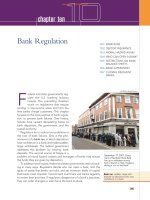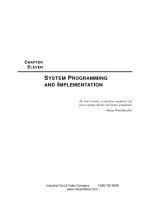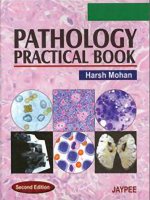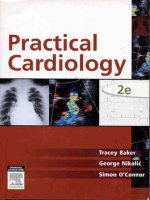Ebook Ultrasound guidance in regional anaesthesia -Principles and practical implementation (2nd edition): Part 1
Bạn đang xem bản rút gọn của tài liệu. Xem và tải ngay bản đầy đủ của tài liệu tại đây (2.02 MB, 125 trang )
Ultrasound Guidance in
Regional Anaesthesia
This page intentionally left blank
Ultrasound
Guidance in
Regional
Anaesthesia
Principles and Practical
Implementation
SECOND EDITION
Peter Marhofer, MD
Professor of Anaesthesia and Intensive Care Medicine
Department of Anaesthesia, Intensive Care Medicine and
Pain Therapy,
Medical University of Vienna,
Vienna, Austria
1
1
Great Clarendon Street, Oxford OX2 6DP
Oxford University Press is a department of the University of Oxford.
It furthers the University’s objective of excellence in research, scholarship,
and education by publishing worldwide in
Oxford New York
Auckland Cape Town Dar es Salaam Hong Kong Karachi
Kuala Lumpur Madrid Melbourne Mexico City Nairobi
New Delhi Shanghai Taipei Toronto
With offices in
Argentina Austria Brazil Chile Czech Republic France Greece
Guatemala Hungary Italy Japan Poland Portugal Singapore
South Korea Switzerland Thailand Turkey Ukraine Vietnam
Oxford is a registered trade mark of Oxford University Press
in the UK and in certain other countries
Published in the United States
by Oxford University Press Inc., New York
© Oxford University Press 2010
The moral rights of the authors have been asserted
Database right Oxford University Press (maker)
First edition published as Ultrasound Guidance for Nerve Blocks, 2008
Second edition published 2010
All rights reserved. No part of this publication may be reproduced,
stored in a retrieval system, or transmitted, in any form or by any means,
without the prior permission in writing of Oxford University Press,
or as expressly permitted by law, or under terms agreed with the appropriate
reprographics rights organization. Enquiries concerning reproduction
outside the scope of the above should be sent to the Rights Department,
Oxford University Press, at the address above
You must not circulate this book in any other binding or cover
and you must impose the same condition on any acquirer
British Library Cataloguing in Publication Data
Data available
Library of Congress Cataloging in Publication Data
Data available
Typeset in Minion by Glyph International, Bangalore
Printed in Great Britain
on acid-free paper by
Ashford Colour Press Ltd., Gosport, Hampshire
ISBN 978–0–19–958735–3
10 9 8 7 6 5 4 3 2 1
Oxford University Press makes no representation, express or implied, that the drug
dosages in this book are correct. Readers must therefore always check the product
information and clinical procedures with the most up-to-date published product
information and data sheets provided by the manufacturers and the most recent codes of
conduct and safety regulations. The authors and the publishers do not accept responsibility
or legal liability for any errors in the text or for the misuse or misapplication of material in
this work. Except where otherwise stated, drug dosages and recommendations are for the
non-pregnant adult who is not breastfeeding.
Dedicated to my parents who supported me always
This page intentionally left blank
Contents
Acknowledgements xi
Foreword by Professor Admir Hadzic xiii
Foreword by Professor Narinder Rawal xv
Foreword: The surgeon’s view by Professor Christian Fialka xvii
Contributors xix
How to use this book xxi
Abbreviations xxiii
1 Basic principles of ultrasonography 1
1.1 Nature of sound waves 1
1.2 Piezoelectric effect 2
1.3 Pulse-echo instrumentation 2
1.4 Resolution and electronic focusing 4
1.5 Time-gain compensation 6
1.6 Measuring velocity with pulsed ultrasound 8
1.7 Ultrasound imaging modes 9
1.8 Common image artefacts 14
1.9 Needle visualization 16
1.10 Equipment needed for ultrasound imaging 18
2 The scientific background of ultrasound guidance in regional
anaesthesia 21
3 Initial considerations and potential advantages of regional
anaesthesia under ultrasound guidance 23
3.1 History of ultrasound-guided regional anaesthesia 23
3.2 Possible advantages of ultrasound-guided regional anaesthesia 24
4 Technique limitations and suggestions for a training concept 33
4.1 Technical limitations 33
4.2 Non-technical limitations 33
4.3 Suggestions for a training concept in ultrasound-guided regional
anaesthesia 34
viii
CONTENTS
5 Have we reached the gold standard in regional anaesthesia? 37
6 Technical and organization prerequisites for
ultrasonographic-guided blocks 41
6.1 Technical considerations 41
6.2 Organization 53
6.3 Post-operative observation 54
6.4 Other considerations 54
7 Ultrasound-guided regional anaesthetic techniques in children:
current developments and particular considerations 57
7.1 Management of minor trauma in children 58
8 Ultrasound appearance of nerves and other anatomical or
non-anatomical structures 63
8.1 Appearance of nerves in ultrasonography 63
8.2 Strategies when nerves are not visible 66
8.3 Appearance of neuronal-related structures in ultrasonography 67
8.4 Appearance of other anatomical structures in ultrasound 71
8.5 Appearance of artefacts in ultrasound 76
9 Needle guidance techniques 81
9.1 Out-of-plane (OOP) needle guidance technique 82
9.2 In-plane (IP) needle guidance technique 82
9.3 How to approach a nerve? 85
10 Pearls and pitfalls 87
10.1 Setting and orientation of the probe 87
10.2 Pressure during injection 87
10.3 Jelly pad for extreme superficial structures 88
11 Nerve supply of big joints 89
11.1 Shoulder joint 89
11.2 Elbow joint 89
11.3 Wrist 90
11.4 Hip joint 90
11.5 Knee joint 91
11.6 Ankle 91
12 Neck blocks 93
12.1 General anatomical considerations 93
12.2 Deep cervical plexus blockade 93
12.3 Superficial cervical plexus blockade 95
12.4 Implication of neck blocks in children 100
CONTENTS
13 Upper extremity blocks 101
13.1 General anatomical considerations 101
13.2 Interscalene brachial plexus approach 102
13.3 Supraclavicular approach 108
13.4 Infraclavicular approach 111
13.5 Axillary approach 114
13.6 Suprascapular nerve block 120
13.7 Median nerve block 122
13.8 Ulnar nerve block 125
13.9 Radial nerve block 128
13.10 Implications of upper limb blocks in children 130
14 Lower extremity blocks 133
14.1 General anatomical considerations 133
14.2 Psoas compartment block 133
14.3 Femoral nerve block 137
14.4 Saphenous nerve block 140
14.5 Lateral femoral cutaneous nerve block 145
14.6 Obturator nerve block 148
14.7 Sciatic nerve blocks 151
14.8 Ankle blocks 163
14.9 Implications of lower limb blocks in children 169
15 Truncal blocks 173
15.1 General anatomical considerations 173
15.2 Intercostal blocks 173
15.3 Ilioinguinal-iliohypogastric nerve blocks 176
15.4 Rectus sheath block 178
15.5 Transversus abdominis plane (TAP) block 183
15.6 Implications of truncal blocks in children 184
16 Neuraxial block techniques 189
16.1 General considerations 189
16.2 Epidural blocks 189
16.3 Paravertebral blocks 193
16.4 Implications in children 196
17 Peripheral catheter techniques 203
18 Future perspectives 205
18.1 Regional blocks for particular patient populations 205
18.2 Education 205
18.3 Technical developments 206
ix
x
CONTENTS
Appendix 1 Zuers Ultrasound Experts regional anaesthesia
statement 209
Appendix 2 Vienna score 219
Appendix 3 Guidelines for the management of severe local
anaesthetic toxicity according to the Association
of Anaesthetists of Great Britain and Ireland
(2007) 221
Appendix 4 Definition of specific terms 225
Index 227
Acknowledgements
A book project like this can never be
undertaken alone. Therefore, the
author gratefully thanks:
Dr Lukas Kirchmair for his invaluable continuous cooperation, his excellent anatomy knowledge, the designing
of anatomical cross-sectional images
to perfectionism and proofreading of
the entire manuscript. Thank you,
Lukas!
Mitchell Kaplan for his excellent
physics chapter. Even I understand
ultrasound physics now. Thank you,
Mitch!
Professor Bernhard Moriggl for
patiently answering hundreds of anatomy questions over the past years. Thank you, Bernhard!
Professor Anette-Marie Machata and Professor Dr.Stephan Kettner for their
excellent hand skills during the preparation of photographs. Thank you,
Anette-Marie and Stephan!
Readers of the first edition for their constructive criticism.
Finally, all my colleagues who have been working with me for many years for
resisting my (sometimes) crossness, and my wife, Daniela, for giving me the
encouragement to complete such a project.
This page intentionally left blank
Foreword
Professor Admir Hadzic
The practice of regional anaesthesia
and peripheral nerve blocks in particular has changed substantially
over the past decade. In fact, it would
not be an overstatement to say that
the new technical developments
in the field tether of making some of
the old teaching to the brink of
obsolete. Most significant developments are the results of technical
advances or, more specifically, the
introduction of ultrasound monitoring for the placement of needles
and catheters. The ability to monitor
the disposition of the local anesthetic is now a key factor in acquiring an
unprecedented control over technique execution. Ultrasound monitoring gives the practitioner insight into the
block dynamics and disposition of the local anesthetics around peripheral
nerves and plexuses. All of this new information has had a cumulative impact
on our understanding of the mechanisms of neural blockade and the relationship between the volume of local anesthetics and a successful blockade. The
idiosyncrasy of nerve stimulation, which was the gold standard for nerve
localization prior to the introduction of ultrasound, is also much better
understood.
However, ultrasound guidance during the administration of peripheral
nerve blocks and increasingly, other regional anaesthesia techniques, was not
an overnight success. Significant efforts were expended, both in advancing and
improving on the ultrasound technology, to provide an image quality level
that allows reliable imaging of the peripheral nerves and needle visualization.
The industry clearly deserves accolades for their efforts to bring this technology within the reach of practising clinicians. However, these developments
would not have been possible without the pioneering efforts of an
xiv
FOREWORD
international group of anaesthesiologists with extraordinary technical knowledge and drive. Indeed, it was the regional anaesthesiologists who fervently
guided the industry to improve the equipment, and who then used every
advance to test the applicability of the new technology for use in neural imaging and the administration of regional anaesthesia. It is for this reason that
compendiums of knowledge from these very think tank echelons are particularly valuable. Professor Peter Marhofer and his Viennese group of collaborators
are uniquely suited to create such a text. They have worked at the forefront to
steer the ultrasound industry and the focus of clinical practice towards the application of ultrasound for use in regional anaesthesia since the mid-nineties.
This second edition of the well-received Ultrasound Guidance in Regional
Anaesthesia: Principles and Practical Implementation expands on the first
edition to include nearly all areas of clinical relevance. The second edition
features some 200 photographs, including cross-sectional views of anatomy in
human cadavers. A new chapter in this edition is ‘Implications in children’
which bridges the information gap on implementing the described technique
in this population as well. Several useful appendices, such as expert consensus
and the management of local anaesthetic toxicity, are also added.
Professor Marhofer and the contributors in Austria (Lukas Kirchmair, MD
and Stephan Kettner, MD), bolstered by the engineering advice from Mitchell
S. Kaplan, PhD, created a uniquely comprehensive, authoritative book on the
use of ultrasound guidance in regional anaesthesia. The use of ultrasound
guidance in regional anaesthesia has allowed for a myriad of modifications and
variations of techniques, indications, and pharmacologic approaches, which
inevitably vary from institution to institution. Not surprisingly, this volume
represents the views and teaching methods of the fabled Viennese school. As
leaders in the specialty of regional anaesthesia and the application of ultrasound, Professor Marhofer and the contributors compiled a uniquely outstanding and an authoritative text based on 16 years of clinical experience and
decades of original research by the group. I wish to sincerely congratulate the
authors and thank them for their immense contribution to the body of knowledge and pursuit of education in ultrasound-guided regional anaesthesia and
beyond.
Admir Hadzic, MD
Professor of Clinical Anaesthesiology
College of Physicians and Surgeons, Columbia University,
Director of Regional Anaesthesia, St. Luke’s-Roosevelt Hospital Centre,
New York, New York, USA
Foreword
Professor Narinder Rawal
In recent decades, the role of
regional anaesthesia has advanced
significantly. Currently, it is widely
practised for surgery in adults and
children and also for the management of post-operative and labour
pain. Improvements in nerve
localization techniques such as
nerve stimulation and ultrasoundguided blocks and the availability
of stimulating catheters have
improved needle and catheter
placement. The accuracy and safety has evolved to such an extent
that perineural catheter techniques are being increasingly used
to treat post-operative pain at
home after ambulatory surgery.
During the last decade, the
explosion of interest in ultrasound visualization to guide local anaesthetic
injection has been truly remarkable. Multiple national and international annual congresses, large numbers of dedicated ultrasound courses in various parts
of the world, sold-out workshops at the European Society of Regional
Anaesthesia and Pain Therapy (ESRA) annual and zonal meetings and other
regional anaesthesia society congresses, the increasing number of publications
on the topic, and the addition of a special section in the journal Regional
Anaesthesia and Pain Medicine in 2007, all testify to the enormous increase in
interest in ultrasonography in regional anaesthesia.
Ultrasonography allows the operator to visualize in real time the relevant anatomy, the nerve, the needle placement, and the spread of local anaesthetic. The enthusiasts claim that ultrasound-guided peripheral nerve blocks are safer because they
have higher success rates and lower rates of complications, are non-invasive (as
opposed to paraesthesia or nerve stimulation techniques), require reduced doses of
local anaesthetics by about 30% or more, provide a faster onset and prolonged
xvi
FOREWORD
duration of blocks, and allow the detection of anatomical variations. However,
there are others who are less impressed and have justifiably asked for good quality
evidence to support these claims. This topic is a regular feature for ‘pros and cons’
debates in many congresses. There is a need for safety studies, efficacy studies, and
equivalence studies of ultrasonic guidance versus conventional techniques for
regional anaesthesia. In developing countries, the high cost of equipment is a major
drawback. One may be for or against ultrasound-guided blocks and the jury is still
out, but it is increasingly difficult to ignore the technique, especially in teaching
institutions. It is also a generational issue that trainees everywhere seem to be asking
for this technology. In short, ultrasonography in regional anaesthesia is here to stay
and we can expect an increasing number of clinicians to practise this technique.
Controlled studies to address the above issues can be expected to become gradually
available which will establish the proper place of ultrasonography in regional anaesthesia in our armamentarium.
A good knowledge of sonoanatomy is crucial for a successful use of the technique. Acquiring technical skills is a major task and a correct needle-transducer
alignment is the commonest error seen in the novices. This book by one of the
pioneers in ultrasound in regional anaesthesia has now come out in its second edition. The first edition was published in September 2008 to critical acclaim. The
author takes up the above issues of benefits and limitations of ultrasound-guided
blocks. The 18 chapters also cover everything from the basic principles of ultrasonography and technical issues to blocks in different parts of the body, including
neck, joint, and trunk blocks in addition to the obligatory upper and lower extremity blocks. In this second edition, Professor Marhofer has added new material
which includes organizational and economic issues, paediatric applications, and
the use of ultrasonography in neuraxial blocks. The overall quality of figures is better than in the first edition and cross-sectional anatomical illustrations are also
included. There is a section on recommendations for the use of ultrasound-guided
regional anaesthesia by a panel of experts from Europe, North America, and Japan.
Professor Marhofer himself is one of the original experts with an experience extending to more than 15 years. His widespread experience in participating in ultrasound
workshops in many parts of the world has been distilled into this new book.
In this book, every aspect of ultrasound-guided blocks has been covered in
detail with emphasis on educating the reader for a safe and effective use of
regional anaesthesia for surgery and pain management. This book will be a major
source for trainees as well as experienced clinicians who will appreciate the wealth
of information it provides for all practitioners of regional anaesthesia.
Professor Narinder Rawal MD, PhD, FRCA (Hons)
Department of Anaesthesiology and Intensive Care,
University Hospital Örebro,
Örebro, Sweden
Foreword: The surgeon’s view
Professor Christian Fialka
Regional anaesthesia in musculoskeletal surgery today represents
the gold standard for a great variety
of procedures. At our institution, we
have the privilege to work with the
group of anaesthetists who pioneered the field of ultrasound-guided regional anaesthesia, especially
the senior author of this textbook.
Therefore, over the years, it has
become a safe and reliable method
for almost all extremity surgical
procedures.
In the early days, regional anaesthesia was not very popular in the
surgical community. Neither landmark-guided nor electro-stimulation-guided techniques for regional
anaesthesia could be used without
showing a significant number of failures such as a delayed or incomplete effect
and the need for an intraoperative conversion to general anaesthesia. Since we
benefit from the development of the ultrasound-guided technique, the latter
cases have become rare exceptions.
Other historical concerns such as the fear of delay due to prolonged preparation time before surgery, especially when compared to cases under general
anaesthesia, disappeared during the past decade because of the positive experience from thousands of cases.
Today, ultrasound-guided regional anaesthesia is favoured not only during
the time of surgery, but also because it provides a good post-operative pain
care. For example, patients who are scheduled for arthroscopic shoulder procedures are provided with a single opiate administration subcutaneously
(7.5mg Piritramid), 8 to 10 hours past the end of the procedure, using the rising analgesic effect of the opiate just before the block loses its effect and the
xviii
FOREWORD: THE SURGEON’S VIEW
pain level increases. Following this protocol, the amount of post-operative
pain medication can be reduced significantly.
In summary, surgeons can recommend ultrasound-guided regional anaesthesia to all patients with standard procedures in bone and joint surgery. These
patients are provided with a safe and reliable anaesthesia procedure as well as
with a satisfying post-operative pain management.
Christian Fialka, MD
Professor of Trauma Surgery
Department of Trauma Surgery,
Medical University of Vienna,
Vienna, Austria
Contributors
Mitchell S. Kaplan, PhD
Principal Engineer, Advanced
Development,
SonoSite Inc.,
Bothell, Washington, USA
Lukas Kirchmair, MD
Department of Anaesthesia and
Intensive Care Medicine,
Medical University of Innsbruck,
Innsbruck, Austria
Stephan Kettner, MD
Professor of Anaesthesia and
Intensive Care Medicine
Department of Anaesthesia,
Intensive Care Medicine and Pain
Therapy,
Medical University of Vienna,
Vienna, Austria
Bernhard Moriggl, MD, FIACA
Professor of Anatomy
Department of Anatomy, Histology
and Embryology,
Medical University of Innsbruck,
Innsbruck, Austria
This page intentionally left blank
How to use this book
This book is written by physicians with 16 years’ experience in ultrasoundguided regional anaesthesia. Focusing specifically on ultrasound-guided
peripheral nerve block techniques, we avoided the inclusion of basic general
knowledge in regional anaesthesia (e.g. indications and contraindications for
specific blocks).
This second edition of the present book has been written after the great success of the first edition. The authors have carefully revised all chapters in order
to provide the most recent knowledge in the topic of ultrasound in regional
anaesthesia. A strong focus is still attached on anatomical descriptions and
subsequent practical implementations. Paediatric applications are now included in this second edition in order to address paediatric anaesthesiologists too.
Neuraxial techniques have also been incorporated to complete the entire
topic.
We strongly suggest careful reading of the introductory chapters of the book.
These include important information about physical background (e.g. how to
adjust and fine-tune an ultrasound machine for optimal imaging), proven
and potential advantages of ultrasound-guided blocks, and prerequisites for
practical performance.
The chapters focusing specifically on blocks include precise descriptions
about the relevant anatomy (including variations) for each block and guidelines for daily clinical practice in the operation room. Paediatric implications
are added in each chapter where applicable. Essential information about each
block is tabulated at the end of each description (see Table 1 for template).
Illustrated ultrasound images, corresponding cross sections, and the respective needle guidance technique are provided for each block description. Figures
of the needle guidance techniques are shown without a sterile probe cover to
demonstrate the exact position of the probe relative to the needle. Where useful, the position of the needle relative to the nerve(s) and/or the distribution of
local anaesthetic are also included. All ultrasound illustrations are performed
with SonoSite M-Turbo equipment except Figure 6.2, which is generously
provided by Ultrasonix.
xxii
HOW TO USE THIS BOOK
Table 1 Description of specific topics for each particular ultrasonographic-guided
nerve block technique
Block characteristic
Basic, intermediate, or advanced technique (see Appendix 1)
Patient position
Typical position of the patient
Ultrasound equipment
Characteristic of the ultrasound probe
Specific ultrasound setting
Frequency of the ultrasound probe (high, medium, low)
Important anatomical
structures
Description of adjacent anatomical structures (vessels,
muscles, tendons, etc.)
Ultrasound appearance of
the neuronal structures
Description of echogenicity and shape of the neuronal
structures
Expected Vienna score
Visibility of the neuronal structures (see Appendix 2)
Needle equipment
Suggested length and tip of the needle
Technique
Description of the needle orientation relative to the
ultrasound probe (In Plane (IP) vs Out Of Plane (OOP))
Estimated local anaesthetic
volume
Suggested volumes of local anaesthetics
Abbreviations
°
€
λ
ADC
ASRA
BMI
c
CI
cm
CPR
CW
2D
3D
dB
ED
e.g
ESRA
f
GPS
h
Hz
i.e.
IIM
IP
kg
kHz
degree
euro
wavelength
analogue-to-digital converter
American Societies of Regional
Anaesthesia and Pain Medicine
body mass index
propagation speed
confidence interval
centimetre
cardiopulmonary resuscitation
continuous-wave
two-dimensional
three-dimensional
decibel
effective dose
for example (exampli gratia)
European Societies of Regional
Anaesthesia and Pain Therapy
frequency
global positioning system
hour
Hertz
that is (id est)
internal intercostal membrane
in-plane
kilogram
kilohertz
LA
LOR
m
mA
mg
MHz
min
mL
mm
m/s
μs
mV
OOP
OR
PRF
PRI
PW
ROI
s
TAP
TGC
THI
TPVS
USA
USB
local anaesthetic
loss-of-resistance
metre
milliampere
milligram
megahertz
minute
millilitre
millimetre
metre per second
microsecond
millivolt
out-of-plane
operating room
pulse repetition frequency
pulse repetition interval
pulsed-wave
region of interest
second
transversus abdominis plane
time-gain compensation
tissue harmonic imaging
thoracic paravertebral space
United States of America
universal serial bus
V
volts
This page intentionally left blank









